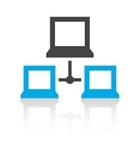Technology needs in healthcare are constantly evolving. Security, accessibility, and compliance are at the top of everyone's priority list because patient privacy is a must-have, but having the right information at the right time is of equal importance. With the recent popularity of cloud services in several other industries, healthcare organizations must decide which of their systems - if any - are appropriate for the cloud. In the case of medical imaging, CDs and DVDs can be a cumbersome and unreliable method for sharing images. For this reason, many hospitals and imaging centers have begun looking into on-premise or cloud solutions to streamline their image sharing efforts. As with any important decision, they must weigh the pros and cons of each option. The top three things to consider when selecting an on-premise or cloud-based medical image sharing software are cost, data, and control. Let’s look at each in a bit more detail...
Cost
 On the surface, cloud-based software may appear to be a cost effective solution for medical image sharing because its pricing is based on usage. For a site that sends or receives a very low volume of studies, this could be an advantage. But for a large hospital network that shares thousands of studies per year, those costs could spike after hitting a threshold set by the vendor. In this situation, there could be significant overages because these variable costs were not initially budgeted.
On the surface, cloud-based software may appear to be a cost effective solution for medical image sharing because its pricing is based on usage. For a site that sends or receives a very low volume of studies, this could be an advantage. But for a large hospital network that shares thousands of studies per year, those costs could spike after hitting a threshold set by the vendor. In this situation, there could be significant overages because these variable costs were not initially budgeted.
In addition to ongoing expenses, healthcare organizations must consider the start-up cost of image sharing software. An on-premise solution may have a higher price tag in the beginning, but the costs will remain steady over time. In many cases, hospitals and their affiliated clinics have already invested heavily in their IT infrastructure and could benefit from leveraging existing equipment and personnel to manage a self-hosted solution, rather than outsourcing to a cloud vendor.
Data
Data security is often a defining factor in choosing a software to share medical images. When it comes to the cloud, file encryption and physical security measures are essential. If the vendor uses a third party hosting provider, the lines blur as to who is ultimately accountable for data security. When privacy is as critical as it is for sensitive patient information, this may be a cause for concern.
For medical image sharing software that is hosted on on-premise servers, security breaches tend to occur on a much smaller scale, often resulting from a single device, such as a laptop, being lost or compromised. To defend against virtual threats, having well-trained IT professionals to oversee firewalls and monitor denial of service attacks is usually sufficient.
Data accessibility is mission-critical for a healthcare organization to deliver the highest quality of care. Relevant medical images need to be in the right hands at the right time and image sharing software fulfills basic need. It can be accomplished with both cloud-based and self-hosted solutions using an internet connection, but speed and file sizes should be taken into account. Downtimes - both planned and unplanned - can have a profound impact on data accessibility. While self-hosted software requires periodic upgrades (every 12 to 24 months), most cloud vendors release new versions and small bug fixes frequently. In either scenario, a contingency plan should be in place to keep your business operating as usual in the event of a service disruption.
Backing up data is just as important as keeping it secure. On-premise servers allow organizations to control how, when, and where sensitive patient information is backed up. Depending on the vendor, any data that has been back up in the cloud may not be accessible for days or even weeks, should some type of outage take place.
Control
One final aspect of this decision-making process that may be overlooked is the element of control. Utilizing the cloud for medical image sharing means that an organization must not only trust the vendor with sensitive patient information, but will also give up control of the related security policies and protocols. Working with a vendor that provides a self-hosted solution means the software is owned and managed internally; therefore, all of the decisions regarding how it is used and protected are up to the discretion of each healthcare organization.
Ultimately, any vendor you choose must be a partner in protecting your patient privacy and maintaining your business operations. By carefully considering cost, data, and control as you evaluate software for medical image sharing, you can ensure that you’re making the right decision for your organization. What are some other things that have weighed heavily on your selection of a vendor or product?
Contact us today to view a demo of Vaultara's self-hosted image sharing software, Flight.

